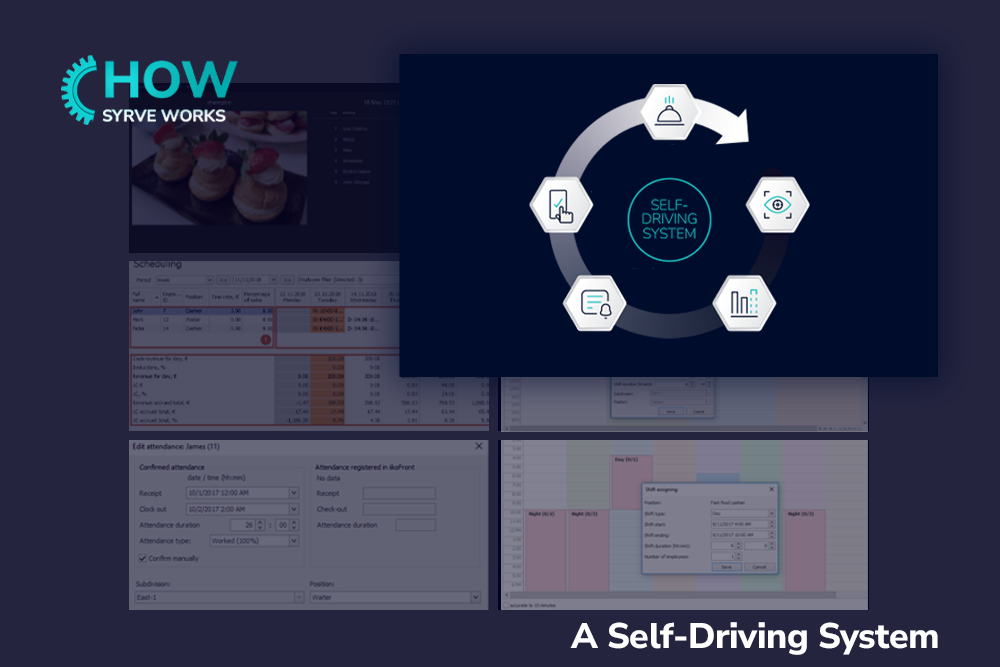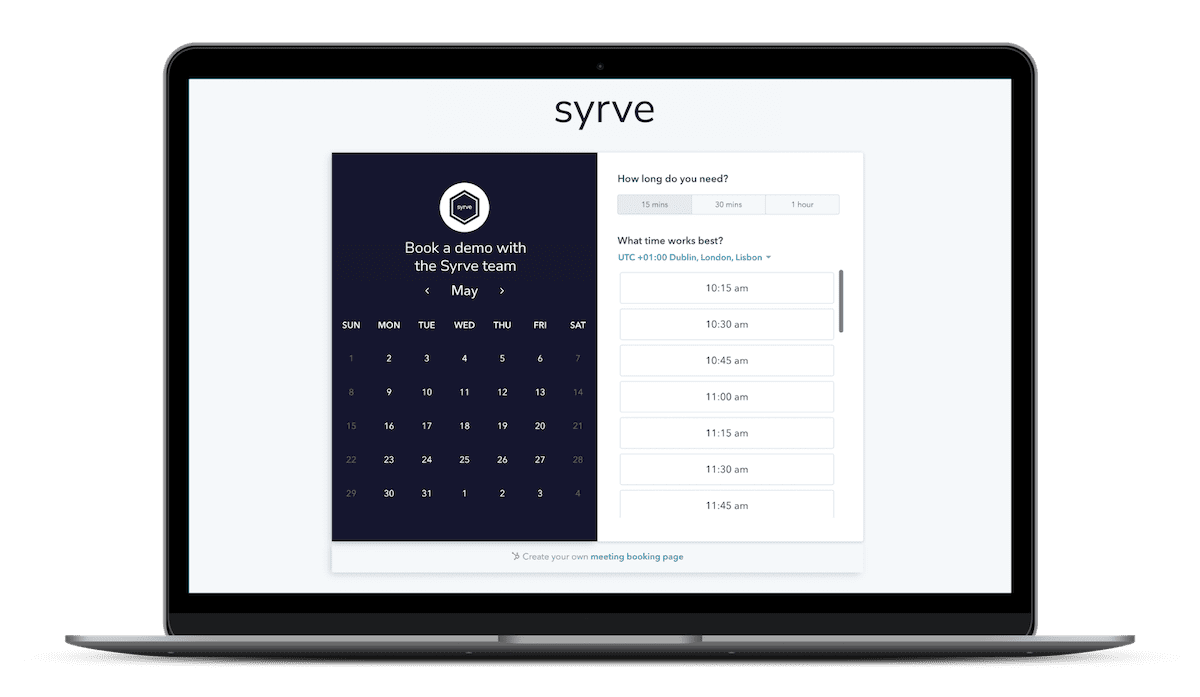We’ve reached the sixth instalment of How Syrve Works. Thus far, we’ve explored core elements of our platform including the KDS, order injection and delivery management.
This time our focus shifts to something less tangible and slightly more abstract, namely the ‘self-driving’ essence of the Syrve platform. It’s something that truly sets us apart from many other ePOS and restaurant management frameworks. So, let’s begin at the beginning.
What is a Self-Driving Restaurant Management System?
A self-driving restaurant management system is one that goes beyond the provision of data and tools. It also runs and streamlines many of the routine, repetitive and error-prone processes that tend to burden restaurant operators and their staff such as inventory control, purchasing and supplier management, cash and sales reconciliation, and staff scheduling.
Whereas many systems simply present information and wait for you to act, a self-driving platform instantly captures operations, makes numerous calculations in real time such as forecasts and preparation plans, and sends out timely notifications when it matters most.
Summary
- Goes Beyond the Provision of Data
- Captures All Operations in Real Time
- Conducts Calculations in Real Time
- Takes Care of Repetitive, Error-Prone Tasks
- Provides Timely Alerts and Notifications
.jpg?width=636&height=424&name=6.10_incontent2%20(2).jpg)
What are the Benefits of a Self-Driving RMS System?
For restaurant operators a genuine self-driving system means less manual oversight, fewer errors and more time to focus on higher-level planning and strategy. In practice, managers are only alerted when anomalies arise, such as a stock discrepancy, a missed task or a sudden demand spike. Instead of constantly firefighting they can let the system take care of routine processes, only stepping in when human judgement is required.
Benefits Summary
- Less Manual Oversight
- Fewer Errors
- Smoother Operations
- Reduced Operating Costs
- Valuable Time Saved
Syrve’s Self-Driving System
Syrve is the embodiment of a genuine self-driving system in operation. It instantly captures all events, makes calculations in real time and alerts managers when issues arise. This effectively shifts the burden of routine work from staff to intelligent automation. Let’s take a closer look at precisely how it all works in practice.
Instant Event Capture and Real Time Data
Fundamental to Syrve is instant event capture. From an order entered at the POS, to purchase acceptances and stock write-offs, every critical operation is captured as it occurs. The result is a live data stream that ensures both the system and manager are always working with the most current information.
As well as generating accurate forecasts, triggering purchases and re-orders, this real-time element is able to provide an accurate, up-to-the-second view of operations. Without it, the platform would slip into a reactive state, constantly playing catch-up instead of steering processes in real time.

Sales Forecasting
One of the most powerful outcomes of a self-driving system is sales forecasting. In conventional systems, forecasting is either a manual or semi-manual process – managers look at reports, sales and in some cases gut instinct, to understand future demand.
In contrast, a self-driving system like Syrve draws on live sales, historical data and external events to produce forecasts with up to 98% accuracy. These forecasts aren’t static - instead, they’re created in 15-minute intervals and drive other automated actions such as prep plans, dynamic staff schedules and supplier orders. Here’s more information on each.
Prep Plans
Accurate forecasting feeds directly into kitchen preparation. By analysing predicted sales according to each dish, Syrve automatically generates prep plans that tell kitchen staff precisely what needs to be readied before service. Aligning production with demand like this has a dramatic cost-saving effect simply because it cuts back on waste.
Staff Scheduling
As it does with preparation plans, Syrve’s forecasting system directly shapes staff scheduling, allowing managers to quickly adjust schedules to meet fluctuating demand. As changes are made, labour costs are adjusted dynamically to ensure that managers remain in budget.
Automated Ordering
Instantly capturing events while constantly monitoring stock levels, Syrve can predict upcoming demand and automatically generate precise purchase orders. Again, forecasting plays a key role here. By combining real-time data with historical trends, the system automatically creates and sends purchase orders.

Alerts and Reminders
Syrve’s notification system covers most if not all of the most critical operational areas including forecasting, cash verification, purchasing workflows and deviations, labour costs and inventory. In keeping with any bona fide self-driving system, these alerts and prompts work on two levels. First, they serve to connect machine driven automation with human judgment. Second, they reinforce operational discipline through task completion reminders, ensuring that nothing is overlooked.
Human Judgement
The human judgement element is perhaps best illustrated with automated purchasing. Before a purchase is made, Syrve will send out an alert to the manager first. While it can also be configured to conduct purchasing automatically, many operators prefer to retain a certain level of control. Such a hybrid approach combines the efficiency of automation with the reassurance of human oversight.
Operational Discipline
Syrve makes full use of live data but also takes into account predefined rules and thresholds. Say, for instance, a scheduled stock count is approaching, it sends out a reminder to a manager. Similarly, if one is missed an alert will be sent.
Crucially, alerts are designed to be targeted and non-intrusive, surfacing only when action is required. This is a defining characteristic of a self-driving system like Syrve: the ability to work silently in the background.
Instead of being bombarded with constant pop-ups, managers need to only be involved when the system detects an anomaly. This exception-based approach means that attention is focused precisely where it’s needed, rather than spread thinly across routine admin. The outcome is less noise and far fewer distractions for managers.

Why Self-Driving Technology is of Critical Importance
Given the well-documented pressures in hospitality, operators need robust tech-driven solutions that operate in the here-and-now. Reports on the past are no longer enough. Precision is non-negotiable. And time has never been more valuable.
By adopting a self-driving platform, managers gain actionable real-time insights from a system that quietly handles routine tasks in the background. The impact is felt across everyday operations and high-level decision-making which translates to greater efficiency, better control and the freedom to focus on growth.



